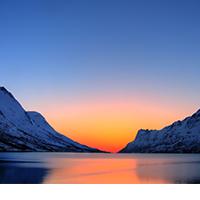The Arctic Ocean has has long been known as a carbon sink, but a new study suggests that while the frigid waters do store large quantities of carbon, parts of the ocean also emit atmospheric carbon dioxide.
Researchers from MIT constructed a model to simulate the effect of sea ice loss in the Arctic, finding that as the region loses its ice, it is becoming more of a carbon sink, taking on about one additional megaton of carbon each year between 1996 and 2007. But while the Arctic is taking on more carbon, the researchers found, paradoxically, the regions where the water is warmest are actually able to store less carbon and are instead emitting carbon dioxide into the atmosphere.
While the Arctic region as a whole remains a large carbon sink, the realization that parts of the Arctic are carbon emitters paints a more complex picture of how the region is responding to global warming.
"People have suggested that the Arctic is having higher productivity, and therefore higher uptake of carbon," said Stephanie Dutkiewicz, an MIT research scientist. "What's nice about this study is, it says that's not the whole story. We've begun to pull apart the actual bits and pieces that are going on."
Dutkiewicz and her colleagues, including Mick Follows and Christopher Hill of MIT, Manfredi Manizza of the Scripps Institute of Oceanography and Dimitris Menemenlis of NASA's Jet Propulsion Laboratory, published their work in the journal Global Biogeochemical Cycles.
To model the Arctic's carbon cycle, the research team developed a model that traces the flow of carbon in the Arctic, looking for conditions that led to the ocean's storage or release of carbon. To accomplish this, the team incorporated three models, which MIT detailed in a news release:
"A physical model that integrates temperature and salinity data, along with the direction of currents in a region; a sea ice model that estimates ice growth and shrinkage from year to year; and a biogeochemistry model, which simulates the flow of nutrients and carbon, given the parameters of the other two models."
The model showed the Arctic taking on an average of 58 megatons of carbon each year, with an average increase of 1 megaton each year between 1996 and 2007. One megaton is 1 million tons.
The model confirms a long held theory: as sea ice melts, more organisms grow, leading to a larger carbon sink as the organisms store carbon.
But there was the anomaly of 2005-2007 where portions of the Arctic released more carbon than they stored. These years saw significant sea ice shrinkage, yet in certain regions, more carbon was emitted than stored. The researchers accounted for the anomaly by factoring in water temperature along with the levels of sea ice loss.
"The Arctic is special in that it's certainly a place where we see changes happening faster than anywhere else," Dutkiewicz said. "Because of that, there are bigger changes in the sea ice and biology, and therefore possibly to the carbon sink."
Link to article:



